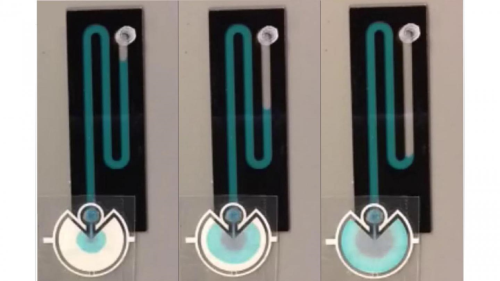
The pumps are suitable for a variety of applications including diagnostics, microfluidic cell culture and process control, and the designs can be adapted for a wide variety of fluids, porous materials and environments.
The biomedical engineering researchers from North Carolina State University and the University of North Carolina at Chapel Hill have filed a patent application on the paper pump technology and are currently looking for industry partners to help bring it to the marketplace.
Portable microfluidic devices
Microfluidic devices are devices that manipulate fluids which have a volume of one microlitre or less – volumes substantially smaller than a single teardrop. These devices hold promise for use in applications ranging from biomedical diagnostic tools to drug testing technologies.
One longstanding challenge to the development of portable, real-world microfluidic device technologies has been the need to find a cost-effective way to pump fluids through the device when outside of the lab, reports Glenn Walker, an associate professor in the joint biomedical engineering programme at NC State and UNC.
“Portability is important, because it makes new applications possible, such as diagnostic tools that can be used in the field," he says.
"Electric pumps, and tubing to connect them, are fine for a laboratory environment, but those aren’t easy to take with you.”
Now Walker and his collaborators have developed a new way to not only pump fluids through microfluidic devices, but to exert substantial control over that flow. They can stop and re-start the flow, control the rate of the flow, and control how long the flow lasts.
The pumps are also extremely cost effective, because they are made from paper.
Lightweight, inexpensive, disposable
The researchers call the pumping system a hydraulic battery.
The 'battery' draws its pumping power from capillary action – the tendency of water (and aqueous liquids such as blood) to be drawn into the pores found in a piece of paper.
“Our system uses pieces of paper that are 125 microns thick, little more than the width of a single hair,” Walker says.
“Capillary action pulls a liquid into the paper. And by changing the shape of the paper, we are able to control how much liquid is pulled through an attached device – and how quickly that happens.”
The shape can be changed in two dimensions by simply cutting out the paper. It can also be manipulated in three dimensions by stacking multiple pumps on top of each other.
“By stacking the paper we are able to create more complex flow profiles, depending on the needs for any given application,” he says.
“And any one of these hydraulic battery pumps costs less than a dime.”
There are other portable means for pumping liquid through a microfluidic device, but Walker believes the paper pump has several significant advantages.
“Our hydraulic battery is small, lightweight, very inexpensive, easy to connect to a device and disposable,” he says.
“In addition, our paper pumps could be saved for later evaluation, such as to run secondary, lab-based tests to confirm on-site diagnoses.”
The team's research is outlined in the paper Modular pumps as programmable hydraulic batteries for microfluidic devices in the journal Technology.





